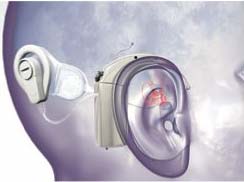The cochlear implant operation is performed under a general anaesthetic, which means the patient will be asleep.
This is what happens during the operation itself.
- a small area of hair behind the ear may be shaved – this will grow back later
- a cut is made behind the ear
- a small bed is drilled in the bone to fit the implant
- the electrode array is placed in the cochlea and is tested to make sure it is working
- the opening in the skin is then sewn up using dissolvable stitches.
Antibiotics are given just before and for a day after surgery to reduce the chance of infection. Before going home, an X-ray is used to check the position of the implant.
Most surgery can take place as a day case, meaning that you can come in and go home on the evening of your operation. This can sometimes be quite late in the evening. It is advised that the adult does not attend work for two weeks following the operation. This may vary according to the adults individual work environment.
After The Operation

Potential Risks/Complications to be considered by Parents and Adults
A cochlear implant is a sophisticated hearing aid requiring an operation. This procedure is considered to be very safe, but as with any other surgical process, there are certain associated risks and complications. Prior to cochlear implant surgery it is important to be fully aware of the following:
- Infection is possible but antibiotics are given to reduce this potential problem.
- Facial nerve weakness rarely occurs as the nerve function is monitored during surgery.
- Balance disturbance and tinnitus are problems which some patients already have. Any balance problems or tinnitus related to surgery should soon settle and is rarely permanent.
- Taste can be affected temporarily.
- Device failure can occur, this can be due to device failure or trauma to the implant site. If this does happen, re-implantation will be offered.
- If you should ever need to have an MRI scan always contact the Cochlear Implant Service, as special precautions must be taken.
There are also risks associated with anaesthesia which should be discussed at your pre-operative assessment.
COCHLEAR IMPLANTS – SAFETY GUIDELINES
Limitations Following a Cochlear Implant Operation:
Following the operation, you will be given an identity card listing the precautions which should be taken. A letter for airport and air travel safety will be issued upon request.
There are limitations on certain activities that could damage or move the implant eg rugby, boxing and squash, although some recipients pursue these activities at their own risk. Swimming is possible if external parts are removed or the appropriate manufacturer’s swimwear used.
There are other precautions to be aware of and users can find more information about safety guidelines from the cochlear implant manufacturerson the BCIG website at https://www.bcig.org.uk/manufacturers-safety-guidelines/
Please refer to these guidelines for further information.
After Care
Can a cochlear implant really change your life? 60 adults receiving cochlear implants were asked to complete a questionnaire once before their implant and then one year afterwards to examine the impact on their lives. The results are interesting.

Confidence, relaxation and independence all show improvement from pre-implant to one year or more post- implant. Negative factors associated with deafness such as isolation and embarrassment show improvement in that these decrease post-implant.
In terms of speech perception as measured by nationally recognised test materials used pre- and post- implant, results show that speech perception with lip-reading improves greatly post-implant for most adults. Some adults are able to understand speech without the need for lip-reading.
Use of Cochlear Implant 94.5% of those responding to the questionnaire used their cochlear implant for eight or more hours a day and 5.5% use their cochlear implant for four to eight hours a day. None of the respondents use their cochlear implant for less than four hours a day.
Implants and Tinnitus The degree of relief from tinnitus will depend on individual circumstances. However, many implant users find that the implant and the sounds it produces substantially mask the tinnitus, but this will depend on individual circumstances.